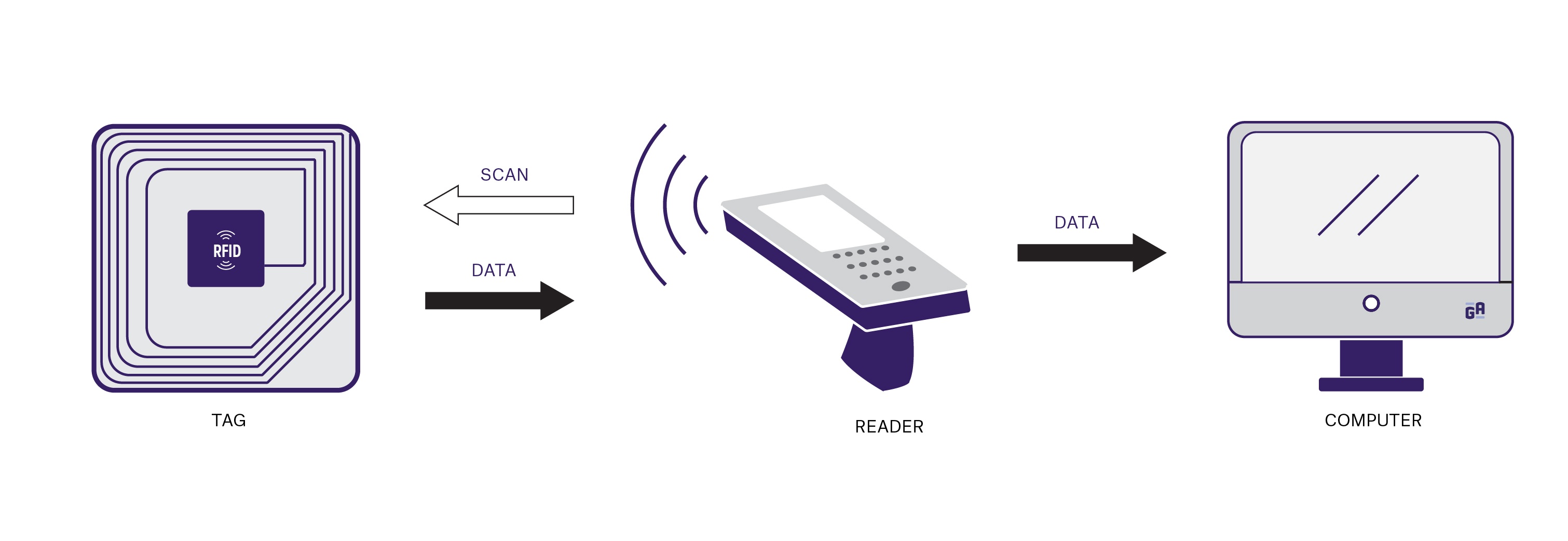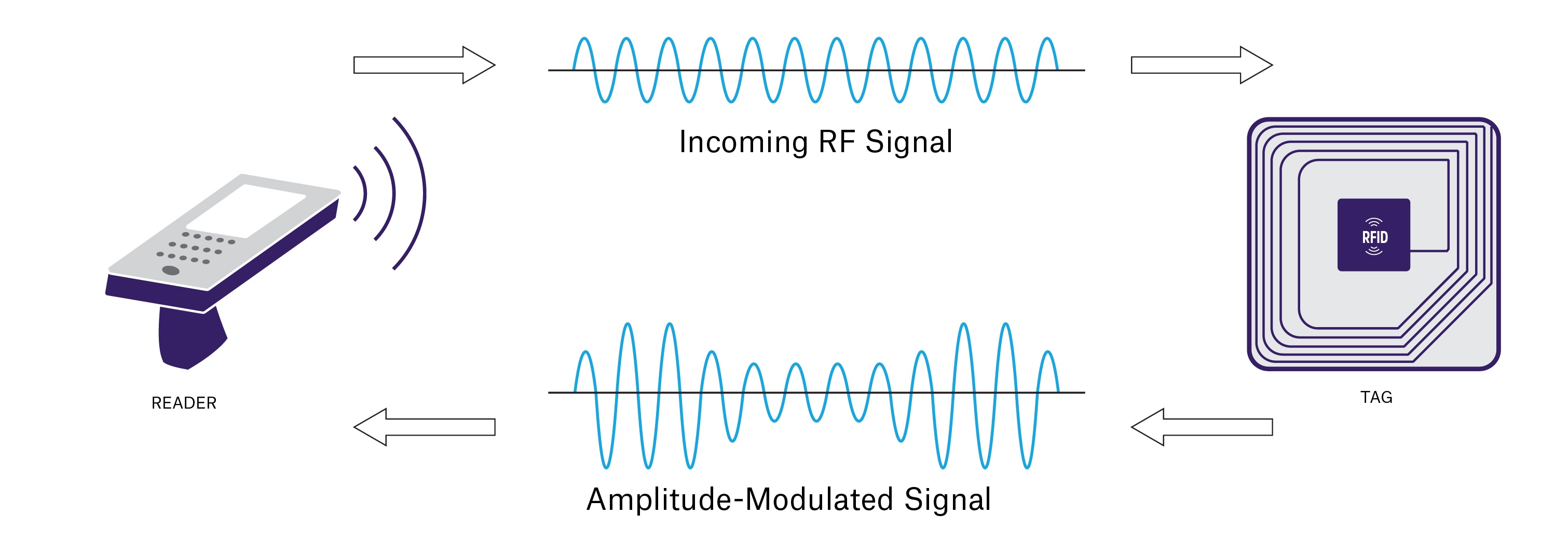 If you’ve read our previous blogs, you already know about printing and barcode technologies and the key role they play in improving identification, traceability and productivity. But did you know that there’s another power technology that businesses and laboratories are using to accomplish even more? Radio Frequency Identification (RFID) is an established technology dating back to its earliest prototypes in 1973, when engineer Mario Cardullo first patented a device that could emit a coded signal in response to remote radio frequencies. Today it exists as a powerful identification tool used in a wide array of industries. It can keep record of medications in hospitals, allow authorized personnel in secure areas, and provides invaluable support to inventory and supply chain tracking. It’s likely that you’ve encountered this technology in your day-to-day life, whether speeding through checkouts with your tap-to-pay chip, stepping through scanners on your way out of the store, or scanning your toll pass on the way to work.
If you’ve read our previous blogs, you already know about printing and barcode technologies and the key role they play in improving identification, traceability and productivity. But did you know that there’s another power technology that businesses and laboratories are using to accomplish even more? Radio Frequency Identification (RFID) is an established technology dating back to its earliest prototypes in 1973, when engineer Mario Cardullo first patented a device that could emit a coded signal in response to remote radio frequencies. Today it exists as a powerful identification tool used in a wide array of industries. It can keep record of medications in hospitals, allow authorized personnel in secure areas, and provides invaluable support to inventory and supply chain tracking. It’s likely that you’ve encountered this technology in your day-to-day life, whether speeding through checkouts with your tap-to-pay chip, stepping through scanners on your way out of the store, or scanning your toll pass on the way to work.
How does RFID technology transmit information?
To understand how information can be passed remotely, sometimes spanning long distances, we need to understand waves. A wave is a disturbance that travels through space or a medium such as air or water. What’s transmitted through the medium is energy, which travels in the form of regular pulses. The distance between these pulses is the wavelength, while the time between pulses determines the wave frequency.
The frequency affects the physical properties of the wave. RFID uses longer wavelengths on the slower end of the electromagnetic spectrum, which encompasses radio waves and microwaves. Within this range, RFID systems work within smaller subranges. For example, ultra-high frequency (UHF) wavelengths span 860-960 MHz, while Near Field Communication (NFC) uses high-frequency signals around 13 MHz.
Active RFID systems are powered by a battery, allowing the ID chip to emit a signal on its own, while passive RFID systems require a scanner to first transmit a radio signal in order for the ID chip to emit a signal in return. Here, we will cover passive RFID systems, as these are far more prevalent due to their convenience, robustness, and capacity to be made in much smaller sizes. The three main components of a passive RFID system include:
-
A tag: This can be attached to a remote object and consists of an antenna and an integrated circuit chip that houses the data used to identify the item.
-
A scanner/reader: This device communicates with the tag by both sending and receiving modulated RF signals.
-
A data processing system (i.e. computer): The RF waves reaching the reader are meaningless unless matched to associated information stored in the database. Host processing systems store all of this information and can distribute it between other remote systems.
How does the tag store and send out data?
Passive RFID tags are powered through electromagnetic induction created by RF signals from the reader. The antenna collects the energy from the incoming RF waves and sends this power to the chip. As the power flows through the circuit of the chip, the current is impeded in a pattern that is specific to that chip, which in turn modulates the signal that is reflected back towards the reader. This is typically achieved through a shift in amplitude, where the signal strength of the reflected wave is varied relative to the incoming waveform. This modulated signal is specific to one chip and, consequently, one item in a database.
 What are the benefits of using RFID technology?
What are the benefits of using RFID technology?
-
Does not require direct visibility: Unlike the traditional 1D and 2D barcodes, which require full visibility and high image quality to be scanned, RFID tags can emit their signal even when covered or embedded within an item. This allows for more freedom in where the tag can be placed and can decrease the risk of the tag becoming unfastened from the item. Furthermore, a scratched or smudged barcode can render it unscannable, whereas RFID tags can be made fairly robust to withstand even the harshest conditions.
-
Stores more data: RFID chips store their information in the form of Electronic Product Code (EPC) and user memory. EPC memory is used to store a specific EPC number that is associated solely with that chip and typically contains 96-128 bits, while some have more. In order for this EPC number to tell us anything about the item, it needs to be used to look up a corresponding entry in a database. Some chips have no user memory, while others can have thousands of bits of storage. Data stored in user memory can be changed and rewritten over time, which is especially useful when the item is involved in an ongoing process that requires updates.
-
Ability to scan multiple items simultaneously: RFID tags allow for scanning from a wide range of angles and can receive multiple backscattered signals at once. This type of bulk-data scanning of numerous items simultaneously can save a tremendous amount of time that would normally be spent scanning individual barcodes one-by-one. Simply scan a container while its contents are read and recorded in seconds.
-
Better data protection and privacy: Originally, security was a concern with these devices. While the tags are very difficult to replicate, their signal is emitted in response to any scanner of the right output signal. However, advancements have allowed for encryption and shielding of this data, ensuring that sensitive information is kept confidential.
How can this help us in the lab?
Suppose you’re looking for a particular sample or freezer box in -80°C storage. Perhaps, like many labs, you need to find this item in one of several freezers full of similar looking racks and boxes. Without a detailed inventory of the sample’s exact location, you might need to open each freezer, checking boxes one by one, removing each tube inside the storage boxes until you find what you need – all the while allowing the temperature to rise and risking the preservation of precious samples and reagents. By implementing RFID labels alongside a LIMS software and database, it’s easy to see what’s inside each box without even opening the lid, saving the researcher time while protecting the samples.
LabTAG by GA International is a leading manufacturer of high-performance specialty labels and a supplier of identification solutions used in research and medical labs as well as healthcare institutions.



